Description
The W-class ships displaced 1,710 long tons (1,740 t) at standard load and 2,530 long tons (2,570 t) at deep load. They had an overall length of 362 feet 9 inches (110.6 m), a beam of 35 feet 8 inches (10.9 m) and a mean deep draught of 14 feet 6 inches (4.4 m). The ships were powered by a pair of Parsons geared steam turbines, each driving one propeller shaft, using steam provided by two Admiralty three-drum boilers. The turbines developed a total of 40,000 shaft horsepower (30,000 kW) which gave a maximum speed of 36 knots (67 km/h; 41 mph). They carried 615 long tons (625 t) of fuel oil that gave them a range of 4,675 nautical miles (8,658 km; 5,380 mi) at 20 knots (37 km/h; 23 mph). Their crew numbered 179 officers and ratings. [1]
The W-class destroyers were armed with four single 4.7-inch (120 mm) Mark IX guns, one quadruple mount for 2-pounder (40 mm) Mk II "pom-pom" anti-aircraft (AA) guns and eight Oerlikon 20 mm (0.8 in) light AA guns on twin mounts. They also were equipped with two quadruple mounts for 21 inch (533 mm) torpedo tubes. For anti-submarine work, the ships were fitted with ASDIC and two rails and four throwers for 70 depth charges. [2] They were equipped with a Type 272 surface-search radar, Type 282 and 285 gunnery radars and a Type 291 early-warning radar. [1]
To better defend the ship against Japanese kamikaze suicide aircraft, Whelp had her searchlight replaced by a 40 mm (1.6 in) Bofors AA gun in mid-1944. [1] As part of her 1962–64 refit, the ship's aft torpedo tubes were removed to make room for a small flight deck and hangar for two Westland Wasp helicopters. A pair of Bofors guns were added, one on each side of the hangar, but these were later replaced by the originally intended pair of American 12.75-inch (324 mm) Mk 32 triple-barrelled anti-submarine torpedo tubes. The main guns were replaced by two twin-gun turrets fitted with 4-inch (102 mm) Mk XVI guns, one forward of the bridge and the other aft of the hangar. Her electronics were modernized as well although she retained the existing search radar. The changes increased her crew to 186–210 officers and ratings. [3]
Construction and career
British service
The W-class destroyers were ordered on 3 December 1941 and Whelp was laid down by Hawthorn Leslie and Company at their shipyard in Hebburn on 1 May 1942. The ship was launched on 3 June 1943 and completed on 14 July 1944. [1] Whelp was adopted by the London Borough of Wembley, using funds they had raised in Warship Week in 1942. [4]
She was initially assigned to the 3rd Destroyer Flotilla (DF) of the Home Fleet and was based in Scapa Flow. During her active service, her captain and first lieutenant were Commander G. A. F. Norfolk and Lieutenant His Royal Highness Prince Philip of Greece and Denmark, the future Duke of Edinburgh. In mid-June, Whelp sailed to Spitsbergen to resupply the small Allied garrison there. [5] [6] Whelp was then assigned to the 27th Destroyer Flotilla which left for the Far East on 2 August and arrived in Trincomalee, Ceylon (now Sri Lanka), on 12 September. [7] En route, the ship covered the Allied invasion of Southern France (Operation Dragoon) in mid-August. [5]
By October, the 27th DF was assigned to the Eastern Fleet in the Indian Ocean and Whelp escorted the aircraft carriers Indomitable and Victorious while their aircraft attacked Nancowry harbour and other targets in the Nicobar Islands as part of Operation Millet. When the Eastern Fleet attempted to attack the oil refinery complex at Pangkalan Brandan, Sumatra, in mid-November, Whelp and her sister ship Wager escorted the oiler RFA Wave King. The British Pacific Fleet (BPF) was formed a few days afterwards and attacked the refinery at Belawan Deli during Operation Robson a month later, as the ship escorted the main body of the fleet. She did much the same during Operation Lentil, another attack on the refinery at Pangkalan Brandan at the beginning of January 1945. Whelp was then detached to tow the damaged submarine HMS Shakespeare to Trincomalee, arriving on 8 January. The BPF departed from the port eight days later, bound for Sydney, Australia. En route its aircraft attacked the refineries in Plaju and Sungai Gerong, Sumatra, on 24 and 29 January (Operation Meridian I & II) before arriving on 10 February. [8] Whelp rescued the crew of a crashed Grumman TBF Avenger, Sub-Lieutenant Roy Halliday and his gunner, Norman Richardson, during the second attack. [9]
On 28 February, the BPF sailed for their forward base at Manus Island and arrived on 7 March and exercised together before sailing for Ulithi on 18 March. The BPF joined the American Fifth Fleet there two days later to participate in the preliminary operations for the invasion of Okinawa. The British role during the operation was to neutralise airfields on the Sakishima Islands, between Okinawa and Formosa, beginning on 26 March. They later attacked airfields in Formosa before returning to the Sakishima Islands. The BPF retired to Leyte Gulf to rest and resupply on 17 April [10] and Whelp, together with Wager, was tasked to escort the badly damaged carrier Illustrious to Sydney on 3 May. [11] They arrived on 14 May and Whelp continued on to Melbourne to begin a refit that lasted until July. [7]
She rejoined the BPF at Sydney (now attached to the United States 3rd Fleet) and on 31 July escorted the battleship Duke of York to Guam, together with Wager, where they arrived on 9 August. Admiral Bruce Fraser, Commander-in-chief of the BPF, conferred with U.S. Admiral Chester Nimitz, the Commander-in-Chief Pacific Fleet Headquarters. The ships then proceeded to rendezvous with the main body of the fleet off the coast of Japan on the 16th. Whelp was the first Allied ship to enter Sagami Bay on 27 August, leading the way for Duke of York and the American battleships Iowa and Missouri. She was present at Tokyo for the formal surrender of the Japanese on 2 September. She left Tokyo on 9 September and, following an overnight stop at Okinawa on 11/12 September, arrived at Hong Kong with Admiral Fraser aboard. He accepted the surrender of the Japanese forces in Hong Kong on 16 September. [12]
Whelp was remained in Hong Kong and conducted anti-piracy patrols along the Chinese coast. On 12 November, the ship departed Hong Kong for Sydney, via Darwin, and arrived there on the 24th to begin a brief refit. She sailed for Britain on 7 December and arrived at Portsmouth on 17 January 1946. Whelp was paid off and was in Category B reserve by 30 May. [7] [12] She was recommissioned on 9 August 1947 and refitted at Portsmouth Royal Dockyard in September–October preparation for the voyage to South Africa in company with her sisters, Kempenfelt, Wessex and Wrangler to form the South Atlantic Reserve Force in Simon's Town. Whelp was damaged while in dock on 8 September 1949. She was scheduled to be converted into a Type 62 air defence frigate, but this was cancelled when that programme was abandoned. [13]
South African service
Whelp was offered to South Africa in 1950, together with Wessex, but she was not purchased until 25 April 1952 for £420,000. [7] The ship was commissioned on 23 February 1953 and was renamed Simon van der Stel, after the first governor of Cape Colony. Much of the ship's service was as a "grey ambassador", on goodwill visits to Europe and the European colonies in Africa, including a 147-day cruise to Europe in 1954. This began on 14 July, when she departed Durban on what was the longest flag-showing cruise ever by an SAN warship. En route to Portsmouth, Simon van der Stel stopped in Freetown, Sierra Leone, and Dakar, French West Africa and arrived there on 31 July. Then she became the first SAN ship to visit, when the warship berthed in Rotterdam, Netherlands, Derry, Northern Ireland, and Glasgow, Scotland. On 21 October, the ship escorted SAS Gelderland (the former HMS Brayford, a new Ford-class seaward defence boat back home. On their way to Durban, the ships visited France, Portugal, the Canary Islands, Dakar, French West Africa, and French Equatorial Africa before arriving at their destination on 8 December, Simon van der Stel having steamed some 17,200 nautical miles (31,900 km; 19,800 mi). [14] This role, however, declined as South Africa became increasingly isolated during the apartheid years. [15]
The ship was placed in reserve from 1957, but was modernised at Simon's Town Naval Dockyard from 1962 to 1964, and re-commissioned on 27 February 1964. She was modernised according to a modified Type 16 frigate standard, her main armament became four 4-inch guns Mk XVI in two twin positions and she was able to carry two Westland Wasp helicopters. [16] Simon van der Stel remained in commission for just over a year as manpower shortages mandated that she be reduced back to reserve in March 1965. The ship was recommissioned on 17 June 1968 and was briefly assigned to the 10th Frigate Squadron until she was redesignated as a training ship on 1 October. Simon van der Stel visited Portuguese Mozambique later that month. In June 1969, she was ordered to proceed to Gough Island to search for two missing members (Jan Seyffert and Fanie Grobler) of the weather station there, but only found their bodies. The ship was replaced in her training role by her sister Jan van Riebeeck in 1972 and she was paid off on 27 March. Simon van der Stel was reactivated with a skeleton crew in early 1975 for a refit at Durban, but she was deemed too expensive to repair and was scrapped there by Sandock-Austral in late 1976. [17]

HMS Illustrious was the lead ship of her class of aircraft carriers built for the Royal Navy before World War II. Her first assignment after completion and working up was with the Mediterranean Fleet, in which her aircraft's most notable achievement was sinking one Italian battleship and badly damaging two others during the Battle of Taranto in late 1940. Two months later the carrier was crippled by German dive bombers and was repaired in the United States. After sustaining damage on the voyage home in late 1941 by a collision with her sister ship Formidable, Illustrious was sent to the Indian Ocean in early 1942 to support the invasion of Vichy French Madagascar. After returning home in early 1943, the ship was given a lengthy refit and briefly assigned to the Home Fleet. She was transferred to Force H for the Battle of Salerno in mid-1943 and then rejoined the Eastern Fleet in the Indian Ocean at the beginning of 1944. Her aircraft attacked several targets in the Japanese-occupied Dutch East Indies over the following year before Illustrious was transferred to the newly formed British Pacific Fleet (BPF). The carrier participated in the early stages of the Battle of Okinawa until mechanical defects arising from accumulated battle damage became so severe she was ordered home early for repairs in May 1945.

HMS Jamaica, a Fiji-class cruiser of the Royal Navy, was named after the island of Jamaica, which was a British Crown Colony when she was built in the late 1930s. The light cruiser spent almost her entire wartime career on Arctic convoy duties, except for a deployment south for the landings in North Africa in November 1942. She participated in the Battle of the Barents Sea in 1942 and the Battle of North Cape in 1943. Jamaica escorted several aircraft carriers in 1944 as they flew off airstrikes that attacked the German battleship Tirpitz in northern Norway. Late in the year she had an extensive refit to prepare her for service with the British Pacific Fleet, but the war ended before she reached the Pacific.

HMS Formidable was an Illustrious-class aircraft carrier ordered for the Royal Navy before the Second World War. After being completed in late 1940, she was briefly assigned to the Home Fleet before being transferred to the Mediterranean Fleet as a replacement for her crippled sister ship Illustrious. Formidable's aircraft played a key role in the Battle of Cape Matapan in early 1941, and they subsequently provided cover for Allied ships and attacked Axis forces until their carrier was badly damaged by German dive bombers in May.
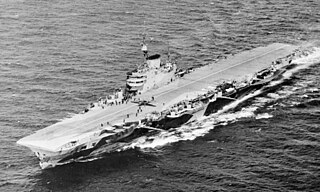
HMS Indefatigable was one of two Implacable-class aircraft carriers built for the Royal Navy (RN) during World War II. Completed in 1944, her aircraft made several attacks that year against the German battleship Tirpitz, inflicting only light damage; they also raided targets in Norway. The ship was transferred to the British Pacific Fleet (BPF) at the end of the year and attacked Japanese-controlled oil refineries in Sumatra in January 1945 before joining the American forces in March as they prepared to invade the island of Okinawa in Operation Iceberg. Indefatigable and the BPF joined the Americans in attacking the Japanese Home Islands in July and August. Following the end of hostilities she visited ports in Australia, New Zealand and South Africa.

HMS Implacable was the name ship of her class of two aircraft carriers built for the Royal Navy during World War II. Upon completion in 1944, she was initially assigned to the Home Fleet and attacked targets in Norway for the rest of the year. She was subsequently assigned to the British Pacific Fleet (BPF) where she attacked the Japanese naval base at Truk and targets in the Japanese Home Islands in 1945. The ship was used to repatriate liberated Allied prisoners of war (PoWs) and soldiers after the Japanese surrender, for the rest of the year. Implacable returned home in 1946 and became the Home Fleet's deck-landing training carrier, a role that lasted until 1950. She briefly served as flagship of the Home Fleet in 1950. During this time she participated in many exercises and made a number of port visits in Western Europe. She was placed in reserve in 1950 and converted into a training ship in 1952, and served as flagship of the Home Fleet Training Squadron. The ship was considered for a major modernisation in 1951–1952, but this was rejected as too expensive and time-consuming. Implacable was decommissioned in 1954 and sold for scrap the following year.

HMS Kent, pennant number 54, was a County-class heavy cruiser built for the Royal Navy in the late 1920s. She was the lead ship of the Kent subclass. After completion the ship was sent to the China Station where she remained until the beginning of the Second World War, aside from a major refit in 1937–38. Kent hunted the German pocket battleship Admiral Graf Spee in the East Indies in late 1939 and then was reassigned to troop convoy escort duties in the Indian Ocean in early 1940. She was transferred to the Mediterranean in mid-1940, but was torpedoed shortly after arriving. The ship was under repair for a year and was then assigned to Home Fleet where she escorted convoys to and from North Russia for the next several years. In mid-1944 Kent escorted British aircraft carriers as their aircraft made attacks on German shipping and airfields in Norway. A few months later she was flagship of a force that intercepted a German convoy in Norwegian waters and sank two freighters and five escorts. The ship was paid off in early 1945 and placed in reserve until she was used as a target. Kent was sold for scrap in 1948.

HMS Electra was a one of nine E-class destroyers built for the Royal Navy during the 1930s. Sunk in the Battle of the Java Sea, Electra was a witness to many naval battles, including the Battle of the Denmark Strait and the sinking of Prince of Wales and Repulse. The ship's wreck was discovered in 2003 and had been badly damaged by illegal salvagers by 2016.

HMS York was the lead ship of her class of two heavy cruisers built for the Royal Navy in the late 1920s. She mostly served on the North America and West Indies Station before World War II. Early in the war the ship escorted convoys in the Atlantic and participated in the Norwegian Campaign in 1940. York was transferred to the Mediterranean theatre in late 1940 where she escorted convoys and the larger ships of the Mediterranean Fleet. She was wrecked in an attack by Italian explosive motorboats of the 10th Flotilla MAS at Suda Bay, Crete, in March 1941. The ship's wreck was salvaged in 1952 and subsequently scrapped.

The Type 16 frigates were a class of British anti-submarine frigates of the Royal Navy. They were based on the hulls of World War II-era destroyers that had been rendered obsolete by rapid advances in technology. They were similar in concept to the Type 15 frigate, but were a far more limited design rendered necessary by budget constraints.
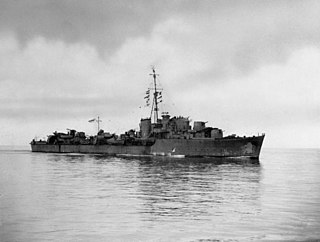
HMS Panther was a P-class destroyer built for the Royal Navy during the Second World War. After commissioning on 12 December 1941, she made a short trip to Iceland with the battleship King George V, then escorted a British convoy to India. In early April 1942, Panther rescued survivors from two cruisers sunk in the Indian Ocean, after which she took part in Operation Ironclad, the Allied invasion of Vichy French-held Madagascar, and sank a French submarine with another destroyer. Panther then returned to the Mediterranean, and participated in the Allied landings in North Africa, but was severely damaged in an air attack and had to undergo repairs in Gibraltar. After taking on survivors from the torpedoed SS Strathallan, Panther escorted two Allied convoys in the Atlantic. She next supported the Allied attack on Sicily, then sailed to the Aegean Sea in the Dodecanese Campaign. On 9 October 1943, Panther was sunk by German Stuka dive-bombers with 33 dead.

HMS Birmingham was a member of the first group of five ships of the Town class light cruisers.

HMS Tartar was a Tribal-class destroyer of the Royal Navy that saw service in most of the naval theatres of World War II. She had an eventful career, eventually receiving the nickname 'Lucky Tartar' due to her numerous escapes from dangerous situations. She was one of only four from the sixteen Royal Navy-operated Tribal-class destroyers to survive the war.
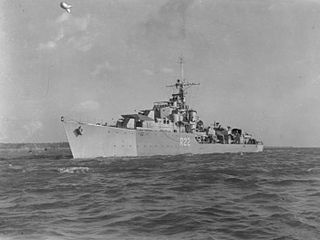
HMS Ursa was a U-class destroyer of the Royal Navy that saw service during the Second World War. She was later converted into a Type 15 fast anti-submarine frigate, with the new pennant number F200.

HMS Wrangler was one of eight W-class destroyers built for the Royal Navy during World War II. Completed in 1944, the ship spent most of the war in the Far East and escorted British aircraft carriers as their aircraft attacked targets in the occupied Dutch East Indies and in Japan itself. Wrangler was present in Tokyo Bay when the Japanese formally surrendered on 2 September 1945.
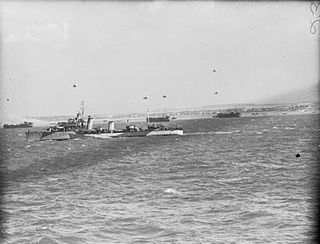
HMS Beagle was a B-class destroyer built for the Royal Navy (RN) around 1930. Initially assigned to the Mediterranean Fleet, she was transferred to the Home Fleet in 1936. She spent most of World War II on escort duty, taking part in the Norwegian Campaign, the Battle of the Atlantic, Operation Torch, the Russian Convoys, and in the Normandy landings before accepting the surrender of the German garrison of the Channel Islands the day after the formal German surrender on 9 May together with another ship.
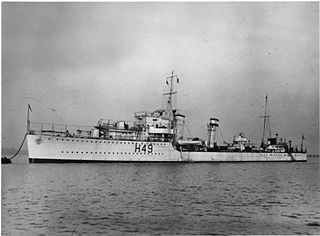
HMS Diana was a D-class destroyer of the Royal Navy. Ordered in 1931, the ship was constructed by Palmers Shipbuilding and Iron Company, and entered naval service in 1932. Diana was initially assigned to the Mediterranean Fleet before she was transferred to the China Station in early 1935. She was temporarily deployed in the Red Sea during late 1935 during the Abyssinia Crisis, before returning to her duty station where she remained until mid-1939. Diana was transferred back to the Mediterranean Fleet just before the Second World War began in September 1939. She served with the Home Fleet during the Norwegian Campaign. The ship was transferred to the Royal Canadian Navy in 1940 and renamed HMCS Margaree. She served for just over a month with the Canadians before being sunk in a collision with a large freighter she was escorting on 22 October 1940.

HMS Escapade was an E-class destroyer built for the Royal Navy in the early 1930s. Although assigned to the Home Fleet upon completion in 1934, the ship was attached to the Mediterranean Fleet in 1935–1936 during the Abyssinia Crisis. During the Spanish Civil War of 1936–1939 she spent considerable time in Spanish waters, enforcing the arms blockade imposed by Britain and France on both sides of the conflict. Escapade was assigned to convoy escort and anti-submarine patrol duties in the Western Approaches when World War II began in September 1939, but transferred back to the Home Fleet at the end of the year.

HMS Escort was an E-class destroyer built for the Royal Navy in the early 1930s. Although assigned to the Home Fleet upon completion, the ship was attached to the Mediterranean Fleet in 1935–36, during the Abyssinia Crisis. During the Spanish Civil War of 1936–1939, she spent considerable time in Spanish waters, enforcing the arms blockade imposed by Britain and France on both sides of the conflict. Escort was assigned to convoy escort and anti-submarine patrol duties in the Western Approaches, when World War II began in September 1939. During the Norwegian Campaign, the ship escorted ships of the Home Fleet, although she did tow her sister HMS Eclipse after the latter ship had been badly damaged by German air attack. Escort was assigned to Force H in late June, and participated in the Attack on Mers-el-Kébir in early July. She was torpedoed a few days later by an Italian submarine, but was towed for three days towards Gibraltar before she foundered.

HMS Wessex was one of eight W-class destroyers built for the Royal Navy during World War II. Completed in 1944, the ship spent most of the war assigned to the Eastern and Pacific Fleets. She screened British aircraft carriers as their aircraft attacked targets in the Japanese-occupied Nicobar Islands, the Dutch East Indies and Okinawa.
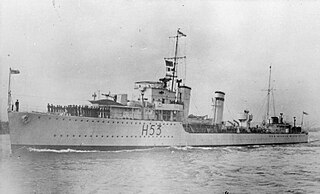
HMS Dainty was a D-class destroyer built for the Royal Navy in the early 1930s. The ship was initially assigned to the Mediterranean Fleet before she was transferred to the China Station in early 1935. She was temporarily deployed in the Red Sea during late 1935 during the Abyssinia Crisis, before returning to her assigned station where she remained until mid-1939. Dainty was transferred back to the Mediterranean Fleet just before World War II began in September 1939. She briefly was assigned to West Africa for convoy escort duties in 1940 before returning to the Mediterranean. The ship participated in the Battle of Calabria in July 1940 and was assigned to convoy escort and patrol duties until she was sunk by German bombers off Tobruk on 24 February 1941.




















